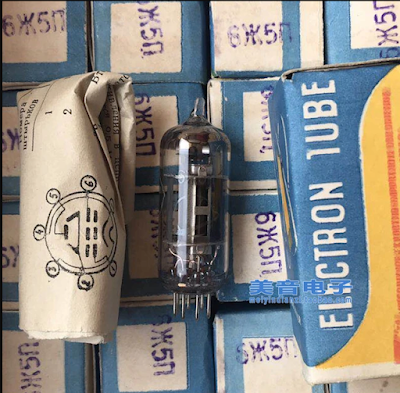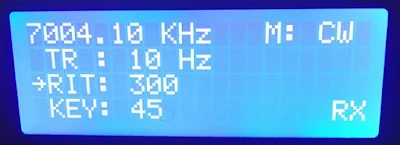Peter Parker VK3YE found this message from Arnie CO2KK in the Wayback Machine. We continue to look for more information on the Jaguey solid state DSB rig.
Arnie wrote:
Several years ago an amateur in central Cuba was approached by some of his young friends to help them build their first rig. CO7PR, Pedro, a telecommunications technician for the phone company, had a vast experience both with vacuum tubes and solid state circuits, plus that special gift of designing and building with whatever is available. After a few days, Pedro came out with the "Islander" prototype, a low parts count, easy to build single band transceiver!
Here is the circuit description of that little radio that has provided many cuban young and old, newcomers to our hobby, with their first rig... and the challenge to improve it.
RECEIVER:
It is a direct conversion, YES, a DC receiver made with vacuum tubes. The very thought of having those tube filaments fed from the AC power supply and at the same time having 80 or 90 dB of amplification made me shudder when I first talked to Pedro on the very popular here 40 meter band! You are LOCO Pedro, I told my good friend... CRAZY, those poor kids are going to hear 50 percent 120 hZ hum when they tune across the 7 megahertz band.
Yes Arnie, you are right, it has a little background hum, but by using a small loudspeaker and small coupling capacitors... it's tolerable! The receiver shares, in its original version, the same antenna input as the transmitter output stage, a PI network, but we soon learned to add a separate LC tuned circuit first and latter a bandpass double tuned input filter...PLUS a signal attenuator... a very primitive but effective attenuator... just a 10 k potentiometer!
For an RF amplifier stage the Islander uses a russian pentode, which is the equivalent of the popular TV IF amplifiers of the 50's... looks like a 6CB6, for those of you that fixed TV sets 40 years ago or so.
The 6 "little spider" five, as everyone knows that tube here,has a lot of gain, and it can be kept rather stable by a judicious choice of screen and cathode resistor values.. Noisy pentagrid converter follows!
The 6A2P... a russian 6BE6, was the first tube type used in the Islanders, later some people tried the ECH81 triode-hexode and found it works better.
The circuit of the 6A2P-6BE6 is quite straighforward... a... you guessed right... PRODUCT DETECTOR... fed from the vacuum tube VFO... and providing its audio output to the two stage audio amplifier.
Audio amplifier is made with a triode-pentode tube of which plenty are locally available from defunct TV's... the ECL82 and the 6F4P and 6F5P of east european and russian manufacture respectively provide a lot of gain.
So... that's your receiver.. quite straightforward, works on 160, 80 and 40 meters by just changing the input filter and the VFO injection, it does NOT provide very good selectivity at all, but during the daytime, when the 40 meter band is used for local and regional contacts, it puts those new hams ON THE AIR!
VFO... the big problem amigos!
CO7PR worked very hard to try to make a stable vacuum tube VFO... and he almost made it..
YES, ISLANDERS drift, some not too much, others are not so good, depending on who built the rig, and how close they followed Pedro's advice at first, and Arnie's CO2KK later (as yours truly became quite involved in the project, as soon as I found that it was THE way of getting all those guys ON THE AIR!)
VFO is made with ONE of the 6 "little spider" 5 pentodes... By the way, I am sure you will like to know why the tube is locally known like that... the ZHE letter of the Cyrillic alphabet is something difficult to pronounce to a cuban - or any other non slavic for the matter - and it resembles like a little spider on the tube's carton and... that's why it is not a 6 "ZHE" 5 but a 6 "little spider" five!!!
The VFO cleverly works at one half the operating frequency... and then it DOUBLES frequency at the plate circuit... output is via a link to the pentagrid or hexode mixer depending on which type you use.
BUT... the VFO also has a second output to the transmitting chain.. Well that's the receiver... OH YES... the VFO is fed from a VR tube, a gaseous discharge voltage regulator similar to a VR-150 or VR-105... CO7PR advises to use the VR105, but when building the Islander, special in the countryside, that's a very hard part to find, as old TV sets don't use VR tubes! So people use whichever VR they can find. ZENERS? They are only available locally for 6 to 24 volts, so they can't be used with this rig.
ISLANDER DSB AND CW transmitter circuit:
From the VFO plate circuit, you pick up 7 mHz energy (usually you must wait at least half an hour for that said 7 mHz energy to be stable enough in frequency) and feed two diodes (ex-video detectors from russian TV type D20) acting as what I like to call BALANCED AND UNBALANCED modulator!
When used for DSB, it is certainly a DSB generator... but when you want to work CW, it must be UNBALANCED.something easy to achieve with just a resistor from the +12 volts line and a switch!
The balanced modulator receives its audio from a carbon microphone capsule salvaged from an old telephone, and conveniently connected to same +12 volts with some additional filtering via biggest possible electrolytic + small ceramic dogbone from TV set IF amplifier as RF bypass... no dogbone capacitor there... strange howls on Islander audio as RF leaks into balanced modulator you know.
So dogbone ceramic capacitor is a must! No, disk ceramics are not locally available, so people must use the next best choice... dogbone ceramics in the 100 pf to 5000 pf range, usually rated at 300 volts or so... (that 300 volt rating we learned the hard way, but more about that later.)
The original version of CO7PR's Islander ran with the carbon microphone, no MIC LEVEL control option, as he really wanted to keep things simple... later versions have audio preamps of various designs, and some even have a sort of primitive compressor.. From the balanced modulator the DSB (plus a little carrier leak that is always there) drives the rig's one or two transistor low level RF amplifier, which is made using whatever NPN silicon transistor is available, usually KT315's salvaged from TV's too. the KT315 is sort of a russian version of the 2N2222, so you understand why we use it here!
RF voltage reaches then the grid of an ex-video output amplifier vacuum tube, and there you are... about 2 to 5 watts of either DSB or CW on 40 meters and a new cuban amateur ON THE AIR!
Before I forget... keying... a little chirpy always because of so many interactions between simple circuits, sometimes not too well shielded, first time builder etc.
BUT... ISLANDER is ON THE AIR providing that young kid from the local junior high school or that doctor that always wanted to be a ham, or maybe the fresh out of school electronic technician, with the fascination of their first ever rig. YES, they drift, and some drift badly, when the frequency determining capacitors in the VFO are not too good... (most of the time), as I said they are a little chirpy. and the receiver's selectivity makes working 40 meters at night almost impossible (although some wizards do make nightime contacts at the low end of 7 mHz) BUT. YES, they are ON THE AIR.
Today there are a few Islanders still on the air, and some are even still built brand new (with many of CO7PR's and CO2KK's mods), but the trend is for all solid state rigs centered around CO5GV's and CO2JA's prototype the "JAGUEY," a design that draws a lot from Wes Hayward's Solid State Design for the Radio Amateur, and as of late, with lots of ideas coming from SPRAT, the G-QRP club magazine and QRPp from NORCAL, the Norther California QRP club!!!
In a future posting I will describe the "Jaguey," too.
-------------
More info on the Cuban DSB and AM rigs can be found here:
https://soldersmoke.blogspot.com/2023/04/more-info-on-cuban-jaguey-solid-state.html
https://soldersmoke.blogspot.com/2023/03/homebrew-am-from-cuba.html
https://soldersmoke.blogspot.com/2023/03/more-cuban-homebrew-from-80s-and-90s.html
https://soldersmoke.blogspot.com/2023/03/schematics-for-cuban-islander-double.html
https://soldersmoke.blogspot.com/2023/03/the-islander-homebrew-dsb-rig-from-cuba.html
https://soldersmoke.blogspot.com/2023/03/needed-more-info-on-cuban-islander-or.html



































